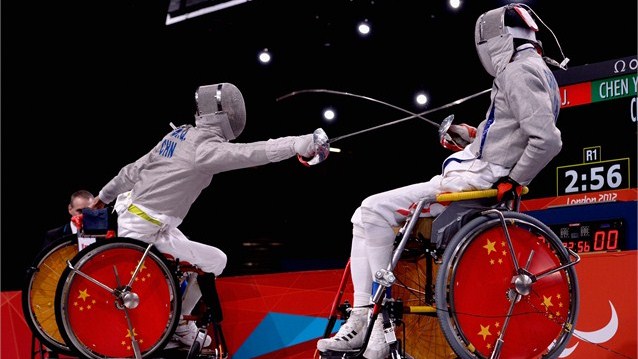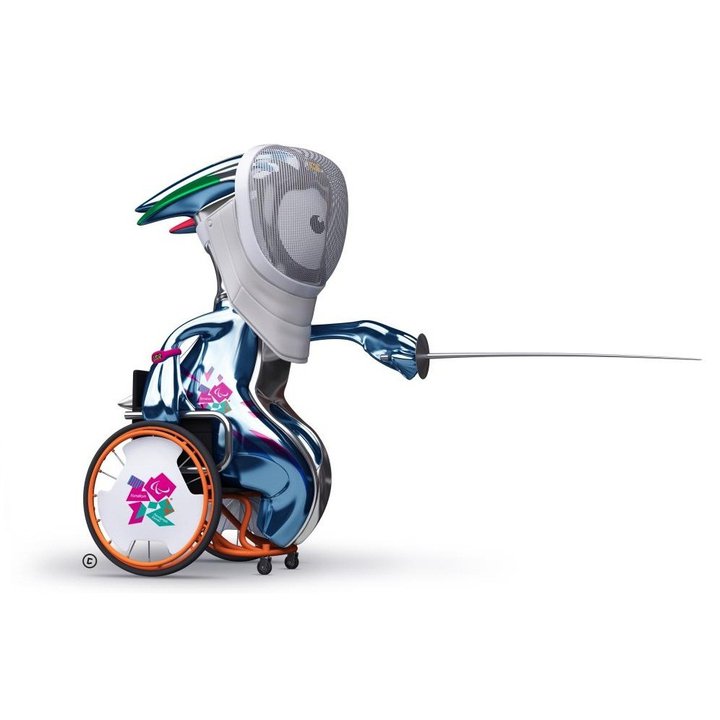
Mark Calhoun (left) from Nellya Fencers and the Shepherd Center in Atlanta has earned a place on the 2008 US Paralympic fencing team and will be heading to Beijing shortly following the conclusion of the Olympic Games.
Learn more about Paralympic Fencing in this audio interview (also available on our Podcast.)
 Carlos Balhana of Fencing.net sat down with Mark Calhoun at the Shepherd Center and asked him to share the details of his training regimen, his assessment of international wheelchair fencing, and his observations on the public’s awareness of the sport.
Carlos Balhana of Fencing.net sat down with Mark Calhoun at the Shepherd Center and asked him to share the details of his training regimen, his assessment of international wheelchair fencing, and his observations on the public’s awareness of the sport.
Mark with coach Julio Diaz at the Shepherd Spinal Center

Transcript:
CB: Hi, I’m Carlos Balhana with Fencing.net, and I am here today with Mark Calhoun from Nellya Fencers in Atlanta and Shepherd Center. Mark just recently qualified for the USA Paralympics fencing team. He fences foil and sabre, and this is an especially significant interview because Mark and I used to be teammates at Nellya Fencers together sometime ago and we used to practice at least – I’d say at least, what? – at least 45 touches every night?
MC: Oh, at least, yeah.
CB: And we would do fencing drills where Mark would flick me on the back repeatedly and in return he would ask me questions that were going to fall on my US citizen naturalization exam. So I owe my citizenship to Mark’s quizzing. (Laughs)
MC: (Laughs) Well, you know, as long as I could help. (Laughs)
CB: Well, he was a lot of help. So, let’s get started: How did you get started in fencing? How long have you been fencing?
MC: Well, I got started in fencing when I went to watch my older brother, James, fence over at AFC – that’s Atlanta Fencers Club – and there happened to be a wheelchair fencer there named Lisa Lanier, and she looked at me and said, “Well, you would qualify,” – because of my cerebral palsy, or CP – “to fence wheelchair.” At first, I was a little skeptical because, well, I could walk. I didn’t know what to think about fencing wheelchair, but I sat down in the chair and fell in love with it, and it’s made me a better person, I think. It’s given me the opportunity to go places that I never would have gone otherwise.
CB: How has wheelchair fencing helped you as a rehabilitation tool? What are some of the positive effects that you’ve seen from wheelchair fencing?
MC: Well, it’s given me a sense of, you know, I guess, pride, is what to say. When I was growing up, it was always like, OK, you’ve got the able-bodied people, and then you had people with disabilities, and it’s given me a sense of the two bringing together. I know a lot of able-bodied fencers really love fencing in the wheelchair, and it helps me out as a fencer and it helps them out in some ways as well.
CB: So you oftentimes practice with able-bodied teammates at the club. Who do you find are the most difficult to fence in the chair: Able-bodied fencers or other wheelchair fencers?
MC: The first few times you fence an able-bodied fencer, it may be a little easier, sometimes, because they don’t know the movement and the tactics of the wheelchair, but a lot of the able-bodied fencers also adapt well after a few times. As far as wheelchair fencers, they are all pretty tough, because they know the movements.They know how to move, and the tactics involved in wheelchair. The funniest thing is when you see an able-bodied person sit in the chair for the first time and they start to try to run away and their legs start kicking back and forth. (Laughs)
CB: (Laughs) I never did that, did I?
MC: Oh yes, you did.
CB: I did? OK (Laughs)
MC: Yeah (Laughs)
CB: So when you practice with able-bodied teammates, what do you find they do differently than wheelchair fencers?
MC: A wheelchair fencer has a lot of fast actions so when I fence an able-bodied person it tends to be a little more tactical. They lay back more and they try to think, whereas, a lot of times, in wheelchair fencing, since we are in such a close proximity, they just BAM! and then it’s done. But when I am fencing an able-bodied person, it helps me work on my tactics.
CB: And unlike in able-bodied fencing, simultaneous attacks are pretty frequent in wheelchair fencing, I guess simply because of the relatively fixed distances of the rack and the chairs. So, generally speaking, how much does that affect your strategy when you are fencing?
MC: Well, just like in able-bodied fencers, it depends on the director; you got to do what the director sees. And sometimes the director will see your attack, and sometimes he’ll see the other guy’s attack, and just like in able-bodied, you just have to try to fence to the director.
CB: To participate in wheelchair events, you are required to compete in at least two weapons, is that right?
MC: Yes, that is correct.
CB: So how does that affect your training schedule? How do you prioritize your training and synthesize the distinct motions and actions that the different weapons impose?
MC: Well, once again, that’s a personal preference to whichever the person wants to fence. I fence foil and sabre, which seems to make the most sense to me because they are both right-of-way weapons, and they seem to feed-off better to me as a fencer.
CB: What are the proportions, you think, in your training schedule? What percentage of it is foil, what percentage of it is sabre?
MC: Well, ultimately, I’d like it to be probably half and half, but right now I am concentrating a little more on foil, so I guess probably about 75% foil, 25% sabre.
CB: What kinds of physical conditioning do you utilize in your training?
MC: I do a lot of sit-ups and ab exercises because, as a wheelchair fencer, that’s where most of the strength and movement comes from, and then I also do my best to try to either walk or run on a treadmill or outside when it is a nice day just to help build up some endurance.
CB: In wheelchair fencing, the frame that holds the two chairs in place is adjustable according to the reach of the fencers’ arms and the fencers with the shortest reach have the option of choosing whether to fence at their distance of the distance set by their opponents. Do you have a particular preference? Does it depend on whether your opponent is a left-handed or right-handed fencer?
MC: Well, honestly, most of the time, I have the longer arm. There are a few people who have longer arms than me, but most of the time it’s me with the longer arm. So, I like to try and fence people with longer arms than me because it helps me extend my reach and stretch out my lunge. And there are some people where I wish that they would fence at my distance because they are just so quick inside and they have the quick parry-riposte so that it’s hard for me to get back in time to get the counter-riposte.
CB: Given that you can’t retreat except for displacing your upper body, what actions do you find to be the hardest to execute in wheelchair fencing as opposed to able-bodied fencing?
MC: A flunge.
CB: (Laughs) But, I mean, are there certain parries that are harder simply because of the wheels? Is there…
MC:…well, you have to be careful not to parry down into your legs; that is what a lot of fencers do. They will parry “four” down into the legs, and then it’s an off-target light but it hurts like hell. (Laughs)
CB: (Laughs)
MC: And then you also have to be aware…the back of the chair is – for competition – is a certain height, so it doesn’t really get in the way, but there are some times where I have gone down to make a parry and banged my elbow on the wheel. It’s just something you have to know about and be able to adjust to it.
CB: So you brought up an interesting point – that the back of the chairs are regulated. What other kinds of regulations are there for the wheelchairs you can use?
MC: There is a certain height of the chair. It has to fit into the size frame; that way you don’t have someone sitting six feet off the tarmac. And then, also, you have a side guard on your off-weapon hand that is supposed to prevent someone from scooting off onto the back wheel and therefore causing a greater distance.
CB: And that’s the same at all levels of competition, international and national?
MC: Yes.
CB: Are you allowed to bring your own chair to international tournaments or do they have regulation chairs already in place?
MC: You have to bring your own chair. And what they do is they have a chair check at the beginning of every tournament where they have usually two or three people that will measure the backs of the chairs, the height of the chairs, the cushions – everything about the chairs – and then they will give you a little sticker, like they would to stamp a mask or lame. And that’s how they determine when you are able to fence with that chair or not.
CB: How important is it to you the make and the build of the chair you use? How can the design of the chair affect your performance at a competition?
MC: Well, the design of the chair is a personal preference, as long as it fits into the specified parameters. So it’s all about what the person feels comfortable with. Some people have a handle bar they like to hold on to, others just hold on to the wheel. I have been hit in the hand many times, but I don’t hold on to the wheel. It’s just all about what the person fencing is more comfortable in and what they feel best insinuates their strengths and weaknesses in the attack, in the bout.
CB: What are some of your more memorable moments? What are your most memorable wins and most memorable losses?
MC: My first World Cup out of the country in Lonato, Italy; it was the first time I made the top 8 in the tournament. And that was my second tournament and I fenced a Ukranian guy to get into the top 8. After that I drew the guy who eventually went on to win the tournament. As far as losses, after that tournament, the next three World Cups I went to, I didn’t make it out of pools. So that was tough to be like, “OK, I am spending all this money to go to these places but I’m not making it out of pools. What am I doing?”. But after that it was a real confidence builder, so it helped me realize that, “Hey, I got a lot of work to do”, and I did the work, and hopefully it will pay off.
I would like to see more publicity and more people interested in the wheelchair because right now the US has a very small contingent of 7-9 male fencers total. I would just like to see something done to get the word more about wheelchair fencing, to get more people who have disabilities and let them know that there is something they can do where, you know, it gives them the opportunity to become a Paralympian. You know? I mean, I’m a small redneck boy from Georgia …
CB: (Laughs)
MC: …and here I am, I am going to Beijing, China for the Paralympics. I mean, 10 years ago I would have said you were crazy, but…
CB: I am crazy. (Laughs)
MC: …well, yeah (laughs), but I would like to see some more – just more publicity – trying to get the word out there to try to bring more people into the sport.
CB: Can you describe your qualifying path? In other words, which tournaments did you compete in to qualify for the Paralympic Games?
MC: I attended three World Cups in order to get into the range to be able to compete in the Paralympics. I competed in Malchow, Germany, most recently; Paris, France; and Warsaw, Poland. And those turned out to be the three biggest World Cups that we have had, so it turned out to be the right ones to go to.
CB: Fencers from different nationalities are sometimes known for having their own distinctive styles. Have you noticed any sort of categorical differences in fencing styles among the wheelchair fencers from different countries?
MC: Yes, I have. The French are just like the French able-bodied. They like the tactics. There are people who do flicks and flick them very well. The Hong Kong and Chinese team are very fast with the straight attacks and they can flick very, very well as well. Just as in able-bodied fencing, the counter-attack and the remise is becoming a little popular – more so the remise than the counter-attack – because, most of the time, if a wheelchair person is laid back trying to avoid an attack, a quick remise can lock out a riposte if need be. So the remise is getting a lot more attention than it used to.
CB: Can you explain for our listeners how wheelchair fencers are grouped and how they are ranked?
MC: There are three categories of wheelchair fencers. Category “A” is the least disabled. They are either usually amputees or CP cases – such as myself. Mainly what it is the amount of stomach muscles that a person has. If a person has use of all their stomach muscles, then they will be classified as an “A”. A “B,” they usually don’t have all of their stomach muscles so they can’t lean as far – lean back and forward as far – so therefore, if an “A” fences a “B,” you know, technically, the “A” should be able to lean out of the way quick and get back. Those are the only two that are going to be competing in the Paralympcs. There is a “C” category but they are not represented at the Paralympics. They are the quadraplegics.
CB: Do you have any sort of rituals that you do at tournaments to prepare for yourself for competition, like listening to music or meditating or anything like that?
MC: I just try to get a good lesson beforehand and then just spend the next few minutes just trying to relax and get my mind set into, “OK, I have got to go out and do what I got to do”. I like to see who is in my pool, so that sometimes helps me decide how I am going to prepare.
CB: What kind of music are you likely to listen to on your iPod right before a bout to help psych you up?
MC: Some Eric Clapton is always good. A little bit of Allman Brothers. You know, if I am feeling really relaxed, I will break out the Jimmy Buffet.
CB: So you are more on the mellow side as opposed to the “amp-me-up” kind of music?
MC: Nah, the “amp-me-up” kind of music gets me all nervous and twitchy.
CB: Oh, OK (Laughs). Well, thank you very much, Mark, for sitting down with me today, and I wish you all the best of luck in the months ahead and all the best to you in Beijing.
MC: Thank you very much, Carlos. It’s been a pleasure.





